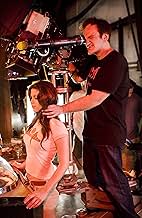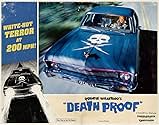Deux groupes de femmes voluptueuses sont traquées à des moments différents par un cascadeur dérangé qui se sert de ses voitures "résistantes à la mort" pour exécuter ses plans meurtriers.Deux groupes de femmes voluptueuses sont traquées à des moments différents par un cascadeur dérangé qui se sert de ses voitures "résistantes à la mort" pour exécuter ses plans meurtriers.Deux groupes de femmes voluptueuses sont traquées à des moments différents par un cascadeur dérangé qui se sert de ses voitures "résistantes à la mort" pour exécuter ses plans meurtriers.
- Prix
- 8 nominations au total
- Jungle Julia
- (as Sydney Poitier)
Histoire
Le saviez-vous
- AnecdotesAfter Zoë Bell was cast, Quentin Tarantino told Bell that he would hire a second stunt person to take Bell's place in the stunt scenes where her face wasn't visible. Bell insisted on performing every stunt herself, saying if someone else were cast in her role, and she was only performing the stunts, those were the stunts she would do. Tarantino honored her request.
- GaffesAs 'Death Proof' is an homage to the old, low-budget Grindhouse films of the 70's and 80's, there are many deliberate errors by the filmmaker to give an authentic Grindhouse feel.
- Citations
Stuntman Mike: [Stuntman Mike and Pam are in his death-proof car, but Pam is in the passenger-seat which is in a crash-box] Well, Pam... Which way you going, left or right?
Pam: [enthusiastic] Right!
Stuntman Mike: Oh, that's too bad...
[ominous sound effect]
Pam: Why?
Stuntman Mike: Because it was a 50-50 shot on whether you'd be going left or right. You see we're BOTH going left. You could have just as easily been going left, too. And if that was the case... It would have been a while before you started getting scared. But since you're going the other way, I'm afraid you're gonna have to start getting scared... immediately!
- Générique farfeluIn the OPENING credits during the prologue driving sequence, after "Kurt Russell in" there is a quick ten-frame color animation of the title "Quentin Tarantino's Thunder Bolt" which cuts immediately to a simple grainy white-on-black title screen that says "Death Proof".
- Autres versionsAfter Zoe flies off the hood, she walks back to the car and says, "Phew that was a close one". In the Unrated Extended version it then cuts right to her line, "So, where's the maniac?" In the U.S. Theatrical Double Feature version there's some extra lines of dialog in between: As Zoe notices that Abernathy and Kim have been crying she remarks, "You guys look like shit. Who died?" Abernathy then asks Zoe if she's okay, to which she replies, "Well, I'm gonna have a hell of a bruise on my bum, but aside from that I'll be sweet."
- ConnexionsEdited from Grindhouse en programme double (2007)
It also sets out to pastiche the "grindhouse" cinema phenomena, with the original idea of two films being shown as a double feature at drive-in movie theatres from state to state, with both films often being re-cut and re-edited, not by the filmmakers, but by the theatre owners themselves. This is evident in the amusing switch in title; with the film opening with the caption 'Quentin Tarantino's Thunderbolt', before awkwardly cutting to an obviously out of place title card with 'Death Proof' crudely emblazoned across the screen. This is also the explanation for the purposeful mistakes in continuity, the sloppy editing and the switch between colour and black and white, as well as the façade of severely deteriorating film stock. It's not sloppy film-making, but rather, a purposeful appropriation of sloppy film-making geared towards appealing to the kind of obsessive movie aficionado who gets the references and can appreciate the joke that Tarantino is attempting to pull.
With this in mind, it seems hard to understand what people are complaining about. Do audiences actual expect this film to keep them enthralled and entertained when the vast majority of them would balk at experiencing many of the low-budget, semi-obscure films that influenced it? Hardly! The accusation here that "nothing happens" is fascicle. The fact that there is film running through the camera is proof enough that something is happening, with the hilariously bland dialog deconstructing the film in much the same way as the purposely amateurish composition, editing and sound all intended to fracture the cinematic language in the same way that Godard did; by reminding the audience that this is the film and the point of the film is to experience the sights and sounds that unfold before us. Added to this the colourful iconography, the music, the characters, the girls in tight t-shirts, the for once entirely justified performance from the man himself, all reminding us that this is a joyous, darkly comic romp in which the point is not "why?" but "why not?".
The effect is reminiscent of Kill Bill (2003), which at times felt superficial or perhaps even too knowing for its own good, but still demonstrated to us the filmmaker's great use of tone, texture, colour and movement, as well as turning many people on to a whole new world of cult Japanese cinema; from the works of highly individual filmmakers like Seijun Suzuki, Kinji Fukasaku and Takashi Miike, to cult performers like Sony Chiba. Death Proof attempts to do something similar with the likes of the American revisionist road movie, the B-cinema of Roger Corman and the femsploitation subgenre of films like The Big Bird Cage (1972), Caged Heat (1975), Day of the Woman (1978) and Ms. 45 (1981); a coolly ironic series of films in which wronged women take bloody revenge in an often elaborate and over the top style, chiefly intended to give a feminist slant to the still rampant degradation and misogyny prevalent in the exploitation genre.
Other reference points are more obvious as they're mentioned explicitly in the film; notably car chase cinema such as Vanishing Point (1971), Two-Lane Blacktop (1971), Dirty Mary, Crazy Larry (1974), Gone in 60 Seconds (1974) and even Spielberg's Duel (1971). Some have complained that the film fails on account of its lack of action and emphasis on dialog and technique, but this seems churlish when you think of the films being referenced; with Vanishing Point featuring a number of cryptic, desert-set sequences in which characters talk and talk and talk, while Two-Lane Blacktop punctuates its scenes of hard driving and drag-racing with much in the way of meandering small-talk. Then we have the fact that films like Reservoir Dogs - which takes place almost entirely within a single setting - and Jackie Brown - which places emphasis entirely on character - use dialog to not only create the characters but to also tell the story.
Regardless of this, Death Proof is meant as a piece of entertainment. There's no real desire here for Tarantino to prove what kind of filmmaker he is because he's already done that with the number of great films that came before. Sure, it can be seen as self-indulgent, but surely those of us familiar with the style of film-making being referenced here will revel in this particular kind of extravagance, loving everything from the continually inane female banter to the awesome scenes of high speed carnage. If you're not a fan cult cinema or exploitation cinema or indeed a devotee of Tarantino's work then this film really isn't going to impress you. There's no shame in that. Some films are made for a niche audience, destined to be a cult in their own right. However, for those who get it, Death Proof has the potential to be a truly exhilarating, one-off piece of film-making.
- ThreeSadTigers
- 11 mars 2008
- Lien permanent
Meilleurs choix
Détails
- Date de sortie
- Pays d’origine
- Langue
- Aussi connu sous le nom de
- Grindhouse présente Quentin Tarantino's à l'épreuve de la mort
- Lieux de tournage
- sociétés de production
- Consultez plus de crédits d'entreprise sur IMDbPro
Box-office
- Brut – à l'échelle mondiale
- 31 126 421 $ US
- Durée2 heures 7 minutes
- Couleur
- Mixage
- Rapport de forme
- 2.35 : 1
Contribuer à cette page









































